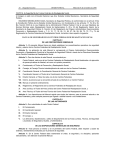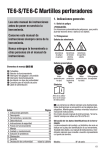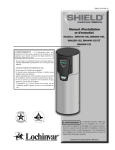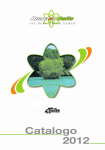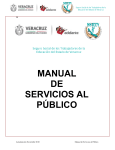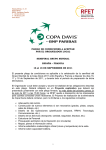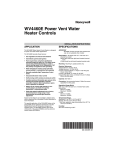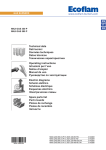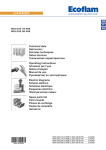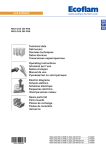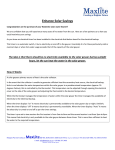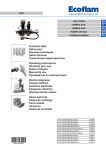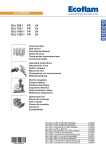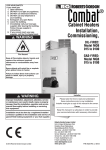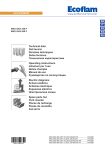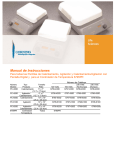Download MAX_GAS_70_105_120PR_CE
Transcript
IT EN FR ES BRUCIATORI A GAS PROGRESSIVI PROGRESSIVE GAS BURNERS BRULEURS GAZ PROGRESSIVES QUEMADOR DE GAS PROGRESIVOS MAX GAS 70 PR MAX GAS 105 PR MAX GAS 120 PR Low Nox 420010386502 30.11.2011 420010386502 Max Gas 70-105-120 PR CARATTERISTICHE OPERATIVE Modello : Max Gas 70-105-120 PR Categoria gas - II 2H 3+B/P Pressione massima* Pressione minima* Combustibile gas P.C.I. Modello : Max Gas 70 PR Portata gas G20 360 12 8.570 G25 360 12 7.370 G31 360 30 22.260 G30 360 30 29.320 max. min. 7,04 Nm3/h 2,52 Nm3/h 8,19 Nm3/h 2,93 Nm3/h 2,71 Nm3/h 0,97 Nm3/h 2,06 Nm3/h 0,74 Nm3/h max. min. 11,21 Nm3/h 4,67 Nm3/h 13,04 Nm3/h 4,68 Nm3/h 4,32 Nm3/h 1,55 Nm3/h 3,28 Nm3/h 1,17 Nm3/h max. min. 12,07 Nm3/h 4,67 Nm3/h 14,04 Nm3/h 4,68 Nm3/h 4,65 Nm3/h 1,55 Nm3/h 3,53 Nm3/h 1,17 Nm3/h mbar mbar kcal/Nm3 Modello : Max Gas 105 PR Portata gas Modello : Max Gas 120 PR Portata gas * : Le pressioni minima e massima effettiva dipendono dalla rampa gas abbinata al bruciatore. I valori sono riportati nel manuale rampe gas. CARATTERISTICHE TECNICHE Potenza termica max. mbar Max Gas 70 PR Max Gas 105 PR Max Gas 120 PR 70 60.340 25 21.600 108 96.100 40 34.480 120 103.450 40 34.480 kW kcal/h kW kcal/h Potenza termica min. Contropressione in camera di combustione CURVE DI LAVORO 4 3,5 MAXGAS GAS70 70PAB PR MAX 3 MAX GAS 120 PR 2,5 2 MAX GAS 105 PR 1,5 1 0,5 0 10 20 10 30 20 30 40 40 50 50 60 60 70 70 80 80 90 100 kcal/h x 1000 100 90 110 120 kW Potenza DIMENSIONI D’INGOMBRO A B D-D1 C E 151 126 N L F O P M G IT MODELLO MAX GAS 70 PR MAX GAS 105 PR MAX GAS 120 PR A B C 303 317 317 155 169 169 148 148 148 D D1 E F G I L 85 185 282 89 160 100/120 100/120 140 220 282 89 160 100/120 100/120 160 240 282 98 160 100/120 100/120 D = TESTA CORTA D1= TESTA LUNGA pag.2 I M N O P M8 M8 M8 52 52 52 71 71 71 82 82 82 420010386502 Max Gas 70-105-120 PR L’installazione deve essere fatta in conformità alle disposizioni locali. 4,0 d=0,8 (b) Lunghezza camera di combustione 3,0 d=0,7 2,0 d=0,6 d=0,5 1,0 0,6 0,5 0,4 I bruciatori sono stati omologati in camere di combustione secondo le norme EN 676. Se le dimensioni della camera di combustione della caldaia, nella quale deve essere installato il bruciatore, è più piccola, consultare il costruttore del bruciatore. d=0,4 d=0,3 0,3 d=0,225 0,2 0,1 12 24 40 (a) 70 100 190 480 1200 2450 kW d = diametro camera di combustione AVVIAMENTO DEL BRUCIATORE CONTROLLI PRELIMINARI Prima di avviare il bruciatore effettuare i seguenti controlli : - Tipo di gas e pressione di alimentazione - Valvole gas chiuse. - La tenuta dei raccordi - Sfiato tubazione gas e controllo pressione entrata - Il cablaggio conforme allo schema e fase e neutro rispettati - L’apertura del termostato caldaia ferma il bruciatore - La tenuta del focolare della caldaia per evitare l’entrata di aria - La tenuta del raccordo camino-caldaia - Condizioni del camino ( stagno, non ostruito,.......). Se tutte queste condizioni sono soddisfatte avviare il bruciatore. L’apparecchiatura di controllo avvia il motore per effettuare ilprelavaggio della camera di combustione. Durante questo periodo di prelavaggio (circa 30 secondi), l’apparecchiatura controlla che la pressione dell’aria sia corretta tramite il pressostato aria. Al termine, dà tensione al trasformatore e apre le valvole del gas. La formazione della fiamma deve avvenire e stabilizzare entro 3 secondi, che é il tempo di sicurezza dell’apparecchiatura. Controllare visivamente la fiamma prima di inserire qualsiasi strumento di controllo nel camino. Regolare e controllare al contatore la portata di gas necessaria alla caldaia. Adeguare alla portata del gas la portata dell’aria per una corretta combustione. CONSIGLI IMPORTANTI Tutti gli organi regolabili devono essere fissati dall’installatore dopo le regolazioni. Ad ogni regolazione controllate la combustione al camino. I valori di CO2 devono essere circa 9,7(G20) 9,6(G25) 11,7(G30) 11,7(G31) ed il CO inferiore a 75 ppm. SISTEMA DI RILEVAZIONE FIAMMA (LANDIS & STAEFA LGB 21/LGB 22 Termostato Motore Pressostato aria Trasformatore Valvola gas Fiamma ≥ 30 s 3s 0,5 s Segnale necessario in entrata Segnale in uscita dell'apparecchiatura CALCOLO DELLA PORTATA DI FUNZIONAMENTO DEL BRUCIATORE Per calcolare la portata di funzionamento, in kW, del bruciatore, procedere nel modo seguente: - Controllare al contatore la quantità di litri erogati e la durata, in secondi, della lettura, quindi procedere al calcolo della portata secondo la seguente formula: e x f = kW s pag.3 e = Litri di gas s = Tempo in secondi G20 = 34,02 G25 = 29,25 f G30 = 116 G31 = 88 IT 420010386502 Max Gas 70-105-120 PR REGOLAZIONE PRESSOSTATO ARIA 2,7 1,5 1,8 2,1 3,0 0,4 1,2 Il pressostato aria deve essere regolato in modo che una insufficiente portata aria non faccia superare il valore di CO a 1% in volume. Dopo aver regolato la portata del gas e attenuto una combustione ottimale (CO2 = 9,5 ÷ 9,8% e CO inferiore a 75 ppm), bisogna regolare il pressostato aria. Togliere il coperchio; durante il funzionamento del bruciatore coprire progressivamente l’aspirazione dell’aria con un cartone in modo da ottenere un valore di CO2 = 10,8 (G 20 - G 25),13 (G 30 - G 31) e un CO inferiore a 5.000 ppm. Regolare il pressostato dell’aria fino all’arresto del bruciatore. Togliere il cartone dall’aspirazione dell’aria e fare ripartire il bruciatore. Rimettere quindi il coperchio. 2,4 0,6 0,9 A B REGOLAZIONE PRESSOSTATO GAS 45 25 30 35 50 Regolare il pressostato ad una pressione del 50% della pressione nominale del gas utilizzato. PRESSIONE NOMINALE : G 20 = 20 mbar G 25 = 25 mbar G 30 = 29 mbar G 31 = 37 mbar 40 20 2,5 5 10 15 C D 1 2 REGOLAZIONE TESTA DI COMBUSTIONE 0 IT + REGOLAZIONE DELLE ELETTROVALVOLE GAS La portata gas di accensione viene accuratamente regolata in fase di collaudo ad 1/3 della portata massima (secondo normativa). L’operazione di eventuale regolazione deve essere effettuata da personale specializzato ed autorizzato ECOFLAM. MULTIBLOC MB-VEF... fig.2 Massima Potenza Agire sulla regolazione V per aumentare o diminuire la portata gas alla massima potenza. (fig.2). Minima Potenza Agire sulla regolazione N per aumentare o diminuire la portata gas alla minima potenza. (fig.2). pag.4 420010386502 Max Gas 70-105-120 PR SERVOCOMANDO ARIA ( SIEMENS SQN 75 ) Togliere il coperchio per accedere alle camme di regolazione. Lo spostamento delle camme va effettuato con l’ausilio dell’apposita chiavetta (in dotazione), e di un giravite a taglio. Descrizione : I - Camma (CELESTE) di regolazione della posizione serranda allo spegnimento (chiusura totale 0°). II - Camma ( ARANCIONE) di regolazione posizione di apertura in accensione e 1° fiamma (con giravite). III - Camma ( ROSSA) di regolazione posizione di apertura in 2° fiamma (potenza max). IV - Camma non usata. CONTROLLO SISTEMA DI RILEVAZIONE FIAMMA A bruciatore spento inserire un microamperometro in corrente continua e scala 0÷50 o 0÷100 µA. Con il bruciatore in funzione, e regolato correttamente, il valore letto dovrà essere stabile e mai inferiore a 3 µA. POSIZIONE ELETTRODI ELETTRODO DI RIVELAZIONE 6 3 ELETTRODO DI ACCENSIONE 30 18 pag.5 IT IT 420010386502 Max Gas 70-105-120 PR MONTAGGIO DEL BRUCIATORE + 3 – 2 1 RIMOZIONE BOCCAGLIO + – pag.6 420010386502 Max Gas 70-105-120 PR MANUTENZIONE CONTROLLO ANNUALE Il controllo periodico del bruciatore (testa di combustione, elettrodi,ecc.) deve essere effettuato da personale autorizzato una o due volte all’anno a secondo dell’utilizzo. Prima di procedere al controllo per la manutenzione del bruciatore è consigliabile verificare lo stato generale del bruciatore e seguire le seguenti operazioni : - Togliere tensione al bruciatore (togliere la spina) - Chiudere il rubinetto di intercettazione gas - Togliere il coperchio del bruciatore, pulire la ventola e l’aspirazione dell’aria - Pulire la testa di combustione e controllare la posizione degli elettrodi - Rimontare i pezzi - Verificare la tenuta dei raccordi gas - Verificare il camino - Far ripartire il bruciatore - Controllare i parametri della combustione (CO2 = 9,7(G 20); 9,6(G 25); 11,7(G 30); 11,7(G 31),(CO = inferiore a 75 ppm) PRIMA DI OGNI INTERVENTO CONTROLLARE : - Che ci sia corrente elettrica nell’impianto e il bruciatore collegato. - Che la pressione del gas sia corretta e il rubinetto di intercettazione del gas aperto. - Che i sistemi di controllo siano regolarmente collegati. Se tutte queste condizioni sono soddisfatte , far partire il bruciatore premendo il pulsante di sblocco. Controllare il ciclo del bruciatore. IL BRUCIATORE NON SI AVVIA : - Controllare l’interruttore, i termostati, il motore, pressione gas. IL BRUCIATORE EFFETTUA LA PREVENTILAZIONE E AL TERMINE DEL CICLO VA IN BLOCCO : - Controllare la pressione dell’aria e la ventola. - Controllare il pressostato aria. IL BRUCIATORE EFFETTUA LA PREVENTILAZIONE E NON ACCENDE : - Verificare il montaggio e la posizione degli elettrodi. - Verificare il cavo di accensione. - Verificare il trasformatore di accensione. - Verificare l’apparecchiatura di sicurezza. IL BRUCIATORE SI ACCENDE E DOPO IL TEMPO DI SICUREZZA VA IN BLOCCO : - Controllare fase e neutro che siano collegati correttamente. - Controllare l’elettrovalvole del gas. - Controllare la posizione dell’elettrodo di rivelazione e la sua connessione. - Controllare l’elettrodo di rivelazione. - Controllare l’apparecchiatura di sicurezza. IL BRUCIATORE SI ACCENDE E DOPO QUALCHE MINUTO DI FUNZIONAMENTO VA IN BLOCCO : - Controllare il regolatore di pressione e il filtro gas. - Controllare la pressione del gas con un manometro. - Controllare il valore di rivelazione (min 3 µA). pag.7 IT 420010386502 Max Gas 70-105-120 PR EN OPERATING FEATURES Models : Max Gas 70-105-120 PR Gas family - II 2H 3+B/P Max. gas pressure* Min. gas pressure* Fuel L.C.V. Model : Max Gas 70 PR Gas flow rate G20 360 12 8.570 G25 360 12 7.370 G31 360 30 22.260 G30 360 30 29.320 max. min. 7,04 Nm3/h 2,52 Nm3/h 8,19 Nm3/h 2,93 Nm3/h 2,71 Nm3/h 0,97 Nm3/h 2,06 Nm3/h 0,74 Nm3/h max. min. 11,21 Nm3/h 4,67 Nm3/h 13,04 Nm3/h 4,68 Nm3/h 4,32 Nm3/h 1,55 Nm3/h 3,28 Nm3/h 1,17 Nm3/h max. min. 12,07 Nm3/h 4,67 Nm3/h 14,04 Nm3/h 4,68 Nm3/h 4,65 Nm3/h 1,55 Nm3/h 3,53 Nm3/h 1,17 Nm3/h mbar mbar kcal/Nm3 Model : Max Gas 105 PR Gas flow rate Model : Max Gas 120 PR Gas flow rate * : Minimum/maximum gas inlet pressures depend by the gas train matched to the burner. The values are written on the gas trains manual. TECHNICAL DATA Termal power max. Max Gas 120 PR 108 96.100 40 34.480 120 103.450 40 34.480 WORKING FIELDS 4 3,5 Backpressure in comb. chamber Max Gas 105 PR 70 60.340 25 21.600 kW kcal/h kW kcal/h Termal power min. mbar Max Gas 70 PR MAXGAS GAS70 70PAB PR MAX 3 MAX GAS 120 PR 2,5 2 MAX GAS 105 PR 1,5 1 0,5 0 10 20 10 30 20 30 40 40 50 50 60 60 70 70 80 80 90 100 kcal/h x 1000 100 90 110 120 kW Output OVERALL DIMENSIONS A B D-D1 C E 151 126 N L F O P G M MODELS A MAX GAS 70 P AB 303 MAX GAS 105 P AB 317 MAX GAS 120 P AB 317 B C 155 169 169 148 148 148 D D1 E 85 185 282 140 220 282 160 240 282 D = SHORT HEAD pag.8 F G I L 89 160 100/120 100/120 89 160 100/120 100/120 98 160 100/120 100/120 D1= LONG HEAD I M N O P M8 M8 M8 52 52 52 71 71 71 82 82 82 420010386502 Max Gas 70-105-120 PR Installation must be carried out in compliance with the local provisions (b) Longueur chambre de combustion 4,0 d=0,7 2,0 d=0,6 d=0,5 1,0 0,6 0,5 0,4 d=0,4 d=0,3 0,3 0,2 The burners have been certified in combustion chambers according to EN 676 standards. Consult the burner manufacturer if the combustion chamber of the boiler in which the burner is to be installed has smaller dimensions. d=0,8 3,0 d=0,225 0,1 12 (a) 24 40 70 100 190 480 1200 2450 kW d = diamètre chambre de combustion STARTING-UP THE BURNER PRELIMINARY CHECKS Before starting up the boiler check the following: - gas type and feed pressure; - gas valves closed; - the seals in the pipe fittings; - gas pipe breather and input pressure; - that the cable complies with the diagram and the phase and neutral wires correspond; - that the burner shuts down when the boiler thermostat opens; - the seal of the boiler furnace which prevents air from entering; - the seal on the flue-boiler pipe fitting; - the condition of the flue (sealed, free from blockage, etc ). If all these conditions are present, start the burner. The control device starts the motor to carry out prewashing of the combustion chamber. During this prewash period (about 30 seconds) the device checks that air pressure is correct via the air pressure switch. At the end, it supplies power to the transformer and opens the gas valves. The flame must be lit and stabilize within 3 seconds, which is the device's safety time limit. Check to ensure the flame is lit before placing any control instrument in the flue. Adjust and check the gas flow necessary for the boiler at the meter. Adjust the air flow according to the gas flow to obtain correct combustion. IMPORTANT ADVICE All adjustable parts must be fixed by the installer after making adjustments. Check flue combustion after each adjustiment. The CO2 values must be approx. 9.7 (G20) 9.6 (G25) 11.7 (G30) 11.7 (G31) axld the CO must be less than 75 ppm. (LANDIS & STAEFA LGB 21/LGB 22 UP CYCLE Thermostat motor Air pressure switch Transformer Gas valve Flame ≥ 30 s 3s 0,5 s Necessary input signal output signal of the device CALCULATION OF WORKING OUTPUT OF THE BURNER To calculate the burner’s working output, in kW, proceed as follows: e = Litres of gas - Check at the meter the quantity of supplied litres and the duration, in seconds, of the reading, then calculate the burner’s output through the following formula: s = Time in seconds e x f = kW s pag.9 f G20 = 34,02 G25 = 29,25 G30 = 116 G31 = 88 EN 420010386502 Max Gas 70-105-120 PR ADJUSTING THE AIR PRESSURE SWITCH 2,7 1,5 1,8 2,1 3,0 0,4 1,2 The air pressure switch must be adjusted so that an insufficient air flow does not allow the CO value to exceed 1% in volume. After having adjusted the gas flow and obtained optimum combustion (CO2 = 9.5 to 9.8% and a CO value of less than 75 ppm), the air pressure switch must be adjusted. Remove the cover with the burner operating, cover the air intake progressively with a piece of cardboard to obtain a value of CO2 = 10.8 (G20-G25)> 13 (G30-G31) and a CO value of less than 5,000 ppm. Adjust the air pressure switch until the burner shuts down. Remove the cardboard from the air intake and start up the burner again. Replace the cover. 2,4 0,6 0,9 A B 45 40 25 30 35 50 5 20 2,5 ADJUSTING THE GAS PRESSURE SWITCH 10 Adjust the pressure switch to 50% of the rated pressure of the gas used. RARED PRESSURE: G 20 = 20 mbar G 25 = 25 mbar G 30 = 29 mbar G 31 = 37 mbar 15 C D 1 2 SETTING THE FIRING HEAD 0 EN + ADJUSTMENT OF GAS SOLENOID VALVES The ignition flow rate is carefully adjusted. during test phase to 1/3 of the maximum flow rate (according to specifications). Operations for eventual further adjustment must be carried out by skilled personnel authorized by ECOFLAM BRUCIATORI. MULTIBLOC MB-VEF... fig.2 Setting at full-load Adjust gas/air ratio with screw V (fig.2). - More CO2 in direction of higher scale values. - Less CO2 in the direction of lower scale value. Setting at low-load Adjust gas flow with screw N (fig.2). - More CO2 in direction of higher scale values. - Less CO2 in the direction of lower scale value. pag.10 420010386502 Max Gas 70-105-120 PR AIR SERVOMOTOR ( SIEMENS SQN 75 ) Remove cover to enter the adjusting cams. Adjust cams through the suitable key (on issue) and a screwdriver. I - Adjusting cam (BLUE) for air damper position on burner’s shutdown (total close 0°). II - Adjusting cam (ORANGE) for opening position in ignition and Low Flame (by the screwdriver). III - Adjusting cam (RED) for opening position in High Flame (max. output). IV - Not used cam. FLAME DETECTION SYSTEM CHECK With the burner switched off, connect a DC microammeter with a 0÷50 or 0÷100 µA dial. When the burner is running, and is properly adjusted, the value read must be steady and never be smaller than 3 µA(Landis). POSITION OF ELECTRODES IONIZATION PROBE 6 3 30 18 pag.11 IGNITION ELECTRODE EN 420010386502 Max Gas 70-105-120 PR EN MOUNTING TO THE BOILER + 3 – 2 1 TUBE DISASSEMBLY + – pag.12 420010386502 Max Gas 70-105-120 PR MAINTENANCE YEARLY INSPECTION Periodic inspection of the burner (combustion head, electrodes, etc.) must be carried out by authorised personnel once or twice a year, depending of use. Before carrying out maintenance inspection on the burner, it is advisable to check its general condition and carry out the following operations: - Disconnect the burner from the power supply (remove the plug). - Close the gas cock. - Remove the burner cover, clean the fan and air intake. - Clean the combustion head and check the position of the electrodes. - Re-assemble the parts. - Check the seal on the gas pipe fittings. - Check the flue. - Restart the burner. - Check the combustion parameters (CO2 = 9.5 to 9.8),(CO = less than 75 ppm) BEFORE EACH INTERVENTION CHECK; - That the system is supplied with power and the burner connected. - That the gas pressure is correct and the gas cock open. - That the control systems are correctly connected. If all these conditions are present, start the burner by pressing the release button. Check the burner cycle. THE BURNER WILL NOT START; - Check the switch, thermostats, motor, gas pressure. THE BURNER PREVENTILATES AND LOCKS AT THE END OF THE CYCLE: - Check the air pressure and fan. - Check the air pressure switch. THE BURNER PREVENTILATES AND WILL NOT IGNITE: - Check the assembly and position of electrodes. - Check the ignition cable. - Check the ignition transformer. - Check the safety devices. THE BURNER STARTS UP AND LOCKS AFTER THE SAFETY TIME LIMIT: - Check that the phase and neutral wires are correctly connected. - Check the gas electrovalves. - Check the position of the detection electrode and its connection. - Check the detection electrode. - Check the safety devices. THE BURNER STARTS UP AND LOCKS AFTER RUNNING FOR A FEW MINUTES. - Check the pressure regulator and the gas filter. - Check the gas pressure with an ammeter. - Check the detection value (min 3 µA Landis). pag.13 EN 420010386502 Max Gas 70-105-120 PR CARACTERISTIQUES OPERATIONNELLES Modele : Max Gas 70-105-120 PR Famille du gaz Pression max. * Pression min. * Combustibile gas P.C.I. Modele : Max Gas 70 PR Débit gaz G20 360 12 8.570 G25 360 12 7.370 G31 360 30 22.260 G30 360 30 29.320 max. min. 7,04 Nm3/h 2,52 Nm3/h 8,19 Nm3/h 2,93 Nm3/h 2,71 Nm3/h 0,97 Nm3/h 2,06 Nm3/h 0,74 Nm3/h max. min. 11,21 Nm3/h 4,67 Nm3/h 13,04 Nm3/h 4,68 Nm3/h 4,32 Nm3/h 1,55 Nm3/h 3,28 Nm3/h 1,17 Nm3/h max. min. 12,07 Nm3/h 4,67 Nm3/h 14,04 Nm3/h 4,68 Nm3/h 4,65 Nm3/h 1,55 Nm3/h 3,53 Nm3/h 1,17 Nm3/h mbar mbar kcal/Nm3 Modele : Max Gas 105 PR Débit gaz Modele : Max Gas 120 PR Débit gaz * : Les pressions minimum et maximum effectives dépendent de la rampe gaz associée au brûleur. Les valeurs sont reportées dans le manuel rampes gaz. CARACTERISTIQUES DU BRULEUR Puissance thermique max. mbar Max Gas 70 PR Max Gas 105 PR Max Gas 120 PR 70 60.340 25 21.600 108 96.100 40 34.480 120 103.450 40 34.480 kW kcal/h kW kcal/h Puissance thermique min. Contrepression en chambre de combustion COURBE DE TRAVAIL 4 3,5 MAXGAS GAS70 70PAB PR MAX 3 MAX GAS 120 PR 2,5 2 MAX GAS 105 PR 1,5 1 0,5 0 10 20 10 30 20 30 40 40 50 50 60 60 70 Puissance 70 80 80 90 kcal/h x 1000 100 90 100 110 120 kW DIMENSIONS D'ENCOMBREMENT A B D-D1 C E 151 126 N L F O P M G FR MODELE MAX GAS 70 PR MAX GAS 105 PR MAX GAS 120 PR A B C 303 317 317 155 169 169 148 148 148 D D1 E F G I L 85 185 282 89 160 100/120 100/120 140 220 282 89 160 100/120 100/120 160 240 282 98 160 100/120 100/120 D = TETE COURTE D1= TETE LONGUE pag.14 I M N O P M8 M8 M8 52 52 52 71 71 71 82 82 82 420010386502 Max Gas 70-105-120 PR L’INSTALLATION DOIT ETRE FAIT SELOM LES DISPOSITIONS LOCALIES. Lunguieur chambre de combustion 4,0 d=0,8 3,0 d=0,7 2,0 d=0,6 d=0,5 1,0 0,6 0,5 0,4 Les bruleurs sont ete homologues dans la chambre de combustion selon les normes EN 676. Si le dimensions de la chambre de combustion de la cHaudiere, dans la quelle il faut installer le bruleur,est plus petite i l faut consulter le constructeur du bruleur. d=0,4 d=0,3 0,3 d=0,225 (b) 0,2 0,1 12 24 40 (a) 70 100 190 480 1200 2450 kW d = diametre cambre di combustion DEMARRAGE DU BRULEUR CONTROLES PRELIMINAIRES Avant de faire démarrer le brûleur, effectuer les contrôles suivants: • Type de gaz et pression d’alimentation.• Soupapes gaz fermées.• Etanchéité des raccords.• Purge canalisation gaz et contrôle pression à l’entrée. • Que le câblage soit conforme au schéma et que la phase et le neutre soient respectés.• Que l’ouverture du thermostat chaudière arrête le brûleur.• L’étanchéité du foyer de la chaudière pour éviter l’entrée d’air. • L’étanchéité du raccord cheminée/ chaudière.• Les conditions de la cheminée (étanche, non bouchée, ...). Si toutes ces conditions sont remplies, faire démarrer le brûleur. Le boîtier de contrôle fait démarrer le moteur pour effectuer le prélavage de la chambre de combustion. Durant ce temps de prélavage (environ 30 secondes), le boîtier contrôle que la pression de l’air soit correcte à l’aide du pressostat air. A la fin de cette opération, il donne du courant au transformateur et ouvre les soupapes gaz. La flamme doit se former et se stabiliser en 3 secondes, qui correspond au temps de sécurité de l’appareil. Contrôler la flamme de façon visuelle avant d’installer un instrument de contrôle quelconque dans la cheminée.Régler et contrôler le débit de gaz nécessaire à la chaudière sur le compteur. Adapter le débit d’air au débit du gaz pour une combustion correcte. CONSEILS IMPORTANTS: Tous les organes réglables doivent être fixés par l’installateur après les réglages. Contrôler la combustion dans la cheminée à chaque réglage. Les valeurs de CO2 doivent être d’environ 9,7 (G20) - 9,6 (G25) - 11,7 (G30) - 11,7 (G31) et le CO doit être inférieur à 75 p.p.m. SYSTEME DETECTION DE FLAMME (LANDIS & STAEFA LGB 21/LGB 22 Thermostat Moteur Pressostat air Transformateur Soupape gaz Flamme ≥ 30 s 3s 0,5 s Signal nécessaire à lʼentrée Signal à la sortie de lʼappareil CALCUL DU DEBIT DE FONCTIONNEMENT DU BRULEUR Pour calculer le débit de fonctionnement, en kW, du brûleur, procéder de la manière suivante: - Vérifier au compteur la quantité de litres débités, ainsi e x f = kW que la durée de la lecture, ensuite procéder au calcul du débit s par la formule suivante: pag.15 e = Litres de gaz s = Temps en secondes G20 = 34,02 G25 = 29,25 f G30 = 116 G31 = 88 FR 420010386502 Max Gas 70-105-120 PR REGLAGE PRESSOSTAT AIR 2,7 1,5 1,8 2,1 3,0 1,2 0,4 0,6 0,9 A B 45 40 25 30 35 50 Le dispositif de surveillance d'air doit être réglé de telle manière qu'il interviene en cas d'insuffisance d'air avant que la teneur en CO des gaz de combustion ne dépasse 1% en volume. Après le réglage du débit gaz et obtention d’une bonne hygiène de combustion (CO2 = 9,5÷9,8 % et CO inférieur à 75 ppm) il faut régler le pressostat d'air. Enlever le couvercle du pressostat. Pendant la marche normale du brûleur, couvrir l'aspiration d'air du brûleur à l'aide d'un morceau de carton, progressivement de maniére à obtenir une valeur de CO2 = 10,6 et le CO inférieur à 10.000 ppm. Tourner progressivement le réglage du pressostat air jusqu'à l'arrêt du brûleur. Enlever le morceau de carton de l'aspiration d'air et faire redémarrer le brûleur. Remettre le couvercle. 2,4 5 20 2,5 REGLAGE PRESSOSTAT GAZ 10 Enlever le couvercle du pressostat. Pendant le fonctionnement du brûleur, mesurer la pression sur le raccord du pressostat et fermer lentement la vanne d’arrêt gaz jusqu’ à ce que la pression mesurée tombe de 50%. Serrer le bouton de réglage jusqu'à l'arrêt du brûleur. Réouvrir la vanne d’arrêt. Remettre le couvercle. G 20 = 20 mbar G 25 = 25 mbar G 30 = 29 mbar G 31 = 37 mbar 15 C D 1 2 REGLAGE TETE DE COMBUSTION 0 FR + REGULATION DES ELECTROVANNES GAZ Le débit gaz d'allumage est soigneusement réglé pendant les essais en usine, à une valeur equivalente à 1/3 de la portée maximale (suivant la normative). L'opération eventuelle de régulation doit être effectuée par un technicien spécialisé et agrée par ECOFLAM BRUCIATORI. MULTIBLOC MB-VEF... fig.2 Puissance thermique max. Agire sulla regolazione V per aumentare o diminuire la portata gas alla massima potenza. (fig.2). Puissance thermique min. Agire sulla regolazione N per aumentare o diminuire la portata gas alla minima potenza. (fig.2). pag.16 420010386502 Max Gas 70-105-120 PR SERVOMOTEUR AIR ( SIEMENS SQN 75 ) Enlever le couvercle pour accéder aux cames. Réguler les cames à l’aide de la clé appropriée(en dotation) et du tournevis. I - Came de régulation (BLEUE) pour la position du clapet d’air à extinction du brûleur (fermer total 0°). II - Came de régulation (ORANGE) pour l’ouverture en allumage et 1e Allure (avec le tournevis). III - Came de régulation (ROUGE) pour la position d’ouverture en 2e Allure (puissance max.). IV - Came de régulation libre (non utilisé). CONTROLE SYSTEME DETECTION DE FLAMME Avec le brûleur éteint, brancher un microamperomètre à courante continue et échelle 0÷50 ou 0÷100 µA. Avec le brûleur en fonction, et dûment régulé, la valeur lue doit être stable et ne jamais être inférieure à 3 µA. POSITIONNEMENT DES ELECTRODES IONIZATION PROBE 6 3 30 18 pag.17 IGNITION ELECTRODE FR 420010386502 Max Gas 70-105-120 PR MONTAGE DU BRULEUR FR + 3 – 2 1 DEMONTAGE DU GUEULARD + – pag.18 420010386502 Max Gas 70-105-120 PR MAINTENANCE CONTROLE ANNUEL: Le contrôle périodique du brûleur (tête de combustion, électrodes etc.) doit être fait, par des techniciens autorisés, une ou deux fois par an, suivant les conditions d’utilisation. Avant de procéder avec les opérations d’entretien, il serait souhaitable d’effectuer une vérification de l’état général du brûleur de la manière suivante: - Débrancher le brûleur du réseau. - Fermer le robinet du gaz. - Enlever le couvercle du brûleur et nettoyer le ventilateur ainsi que le conduit d’aspiration d’air. - Nettoyer la tête de combustion et vérifier la position des électrodes. - Remonter le tout. - Vérifier l’étanchéité des raccords gaz. - Contrôler la cheminée. - Redémarrer le brûleur et en contrôler les paramètres de combustion (CO2 = 9,7% (G 20); 11,7% (G 30); 11,7% (G 31); CO inférieur a 75 ppm). Avant de chaque intervention contrôler: Qu’il y soit courante électrique dans l’installation et que le brûleur soit branché. - Que la pression du gaz soit celle correcte et que le robinet du gaz soit ouvert. - Que les dispositifs de contrôle soient dûment branchés. - Lorsque toutes ces conditions sont satisfaites, démarrer le brûleur en appuyant sur le bouton du réarmement de la mise en sécurité, et en vérifier la séquence d’allumage. BREVE GUIDE AU DEPANNAGE: - Le brûleur ne démarre pas: contrôler l’interrupteur d’allumage, les thermostats, le moteur, la pression du gaz et le dispositif du contrôle d’étanchéité (s’il y en a). - Le brûleur effectue le prébalayage mais se met en sécurité à la fin du cycle: contrôler la pression de l’air, le ventilateur ainsi que le pressostat air. - Le brûleur effectue le prébalayage mais ne s’allume pas: vérifier le montage et la position des électrodes, le câble d’allumage, le transformateur d’allumage, le coffret de sécurité et les électrovannes du gaz. - Le brûleur s’allume mais se met en sécurité après l’écoulement du temps de sécurité: contrôler que la phase et le neutre soient dûment connectés; contrôler position et connexion de la sonde d'ionisation; vérifier le coffret de sécurité. - Le brûleur s’allume normalement mais se met en sécurité après quelques minutes de fonctionnement: contrôler le régulateur de pression et le filtre gaz; contrôler la pression du gaz; contrôler la valeur de détection (3 µA min.); contrôler les valeurs de la combustion. pag.19 FR 420010386502 Max Gas 70-105-120 PR CARACTERÍSTICAS OPERATIVAS Modelo : Max Gas 70-105-120 PR Presión gas máx.* Presión gas mín.* Combustible gas P.C.I. Modelo : Max Gas 70 PR Caudal gas Familia de gas G25 G31 360 360 12 30 7.370 22.260 G20 360 12 8.570 mbar mbar kcal/Nm3 Modelo : Max Gas 105 PR Caudal gas G30 360 30 29.320 max. min. 7,04 Nm3/h 2,52 Nm3/h 8,19 Nm3/h 2,93 Nm3/h 2,71 Nm3/h 0,97 Nm3/h 2,06 Nm3/h 0,74 Nm3/h max. min. 11,21 Nm3/h 4,67 Nm3/h 13,04 Nm3/h 4,68 Nm3/h 4,32 Nm3/h 1,55 Nm3/h 3,28 Nm3/h 1,17 Nm3/h Modelo : Max Gas 120 PR Caudal gas max. 12,07 Nm3/h 14,04 Nm3/h 4,65 Nm3/h 3,53 Nm3/h min. 4,67 Nm3/h 4,68 Nm3/h 1,55 Nm3/h 1,17 Nm3/h * : Las presiones mínima y máxima efetivas dependen del circuito del gas montado en el quemador. Los valores se encuentran en el manual del circuito del gas. CARACTERISTICAS TECNICAS Potencia térmica máx . mbar Max Gas 70 PR Max Gas 105 PR Max Gas 120 PR 70 60.340 25 21.600 108 96.100 40 34.480 120 103.450 40 34.480 kW kcal/h kW kcal/h Potencia térmica míx . CAMPO DE TRABAJO 4 3,5 Contropresión en cámara de combustión MAXGAS GAS70 70PAB PR MAX 3 MAX GAS 120 PR 2,5 2 MAX GAS 105 PR 1,5 1 0,5 0 10 20 10 30 20 30 40 40 50 50 60 60 70 70 Potencia 80 80 90 kcal/h x 1000 100 90 100 110 120 kW DIMENSIONES TOTALES A B D-D1 C E 151 126 N L F O P M G ES MODELO MAX GAS 70 PR MAX GAS 105 PR MAX GAS 120 PR A B C 303 317 317 155 169 169 148 148 148 D D1 E F G I L 85 185 282 89 160 100/120 100/120 140 220 282 89 160 100/120 100/120 160 240 282 98 160 100/120 100/120 D = CABEZA CORTA D1= CABEZA LARGA pag.20 I M N O P M8 M8 M8 52 52 52 71 71 71 82 82 82 420010386502 Max Gas 70-105-120 PR La instalación debe ser efectuada en conformidad a las disposiciones locales. (b) Largueza decamera la cámara de combustión Lunghezza di combustione 4,0 Los quemadores han sido homologados en cámaras de combustión según las normas EN 676. Si las medidas de la cámara de combustión de la caldera, en la cual debe ser instalado el quemador, son más pequeñas, consultar al fabricante del quemador. d=0,8 3,0 d=0,7 2,0 d=0,6 d=0,5 1,0 0,6 0,5 0,4 d=0,4 d=0,3 0,3 d=0,225 0,2 0,1 12 24 40 (a) 70 100 190 480 1200 2450 di combustione kW d = diametro Diámetrocamera de la cámara de combustión PUESTA EN MARCHA DEL QUEMADOR CONTROLES PRELIMINARES Antes de poner en marcha el quemador, efectuar los siguientes controles: • Tipo de gas y presión de alimentación. • Válvulas del gas cerradas. • Estanqueidad de las conexiones.• Purgar la tubería del gas y control de la presión en ingreso. • Que el cableado sea conforme al esquema, con respeto de la fase y neutro.• Que el quemador se pare cuando el termostato caldera se abre. • La estanqueidad del hogar para evitar el ingreso de aire. • La estanqueidad de la conexión caldera-chimenea. • La condición de la chimenea (estanco, non obstruido...). Al cumplir de todas estas condiciones poner en marcha el quemador. El equipo de control arranca el quemador para efectuar el prebarrido de la cámara de combustión. Durante este periodo de prebarrido (cerca de los 30 segundos) el equipo comprueba que la presión del aire sea correcta por medio del presostato del aire. Al termino alimenta el transformador y abre las válvulas del gas. La formación de la llama tiene que efectuarse y estabilizarse dentro de los 3 secundos, que es el tiempo de seguridad del equipo. Averiguar a vista la presencia de la llama antes de introducir cualquiera instrumentación de control. Regular y comprobar el caudal del gas necesario a la caldera por medio del contador. Adecuar el caudal del aire al caudal del gas para obtener una combustión correcta. ADVERTENCIAS IMPORTANTES Todos los equipos regulables tienen que ser fijados por el instalador después de cada regulación. Por cada regulación comprobar la combustión a la chimenea. Los valores de CO2 deben ser cerca de 9,7 (G20) 9,6 (G25) 11,7 (G30) 11,7(G31) y el CO inferior a los 75ppm. LANDIS & STAEFA LGB 21/LGB 22 Termóstato Motor Presóstato aire Transformador Gas válvula Llama 3s ≥ 30 s 0,5 s Signal necesario en ingreso Signal a la salida de equipo CALCULO DE LA POTENCIA DE FUNCIONAMIENTO DEL QUEMADOR Para calcular la potencia de funcionamiento, en kW, del quemador, proceder de la manera siguiente: Comprobar al contador la cantidad de litros suministrados y la duración, en segundos, de la lectura, luego proceder al calculo de la potencia con la e x f = kW formula siguiente: s pag.21 e = Litri di gas s = Tempo in secondi G20 = 34,02 G25 = 29,25 f G30 = 116 G31 = 88 ES 420010386502 Max Gas 70-105-120 PR REGULACIÓN DEL PRESÓSTATO AIRE 2,7 1,5 1,8 2,1 3,0 0,4 1,2 El presóstato aire tiene que ser regulado de modo que un caudal de aire insuficiente no le permita de superar el valor de CO a 1% en volumen. Después de haber regulado el caudal del gas y haber obtenido una combustión optimal (CO2 = 9,5÷9,8% y CO inferior a 75 ppm), se necesita regular el presóstato del aire de la siguiente manera: - Remover la tapa del presóstato; durante la marcha del quemador, obstruir progresivamente la toma del aire con un tarjetón, de manera a obtener un valor de CO2 = 10,8 (G20 - G25) 13 (G30 - G31) y un CO inferior a 5.000 ppm. - Regular el presóstato del aire hasta al apagado del quemador. - Remover el tarjetón de la toma del aire y reponer en marcha el quemador. 2,4 0,6 0,9 A B - Remontar la tapa. 45 40 25 30 35 50 REGULACIÓN DEL PRESÓSTATO GAS 5 20 2,5 - Regular el presóstato a una presión del 50% de la presión nominal del gas utilizado. Presión Nominal: G 20 = 20 mbar G 25 = 25 mbar G 30 = 29 mbar G 31 = 37 mbar 10 15 C D 1 2 REGULACIÓN CABEZA DE COMBUSTION 0 ES + REGULACIÓN DE LA ELECTROVALVULAS GAS El caudal de encendido del gas ya está cuidadosamente regulada durante el ensaye, a 1/3 del caudal máximo (según las normas). Una operación eventual de regulación debe ser efectuada por un técnico especializado y autorizado por ECOFLAM BRUCIATORI. MULTIBLOC MB-VEF... fig.2 Potencia térmica máx. Agire sulla regolazione V per aumentare o diminuire la portata gas alla massima potenza. (fig.2). Potencia térmica min. Agire sulla regolazione N per aumentare o diminuire la portata gas alla minima potenza. (fig.2). pag.22 420010386502 Max Gas 70-105-120 PR SERVOMOTOR AIRE ( SIEMENS SQN 75 ) Sacar la tapa para acceder a las levas de regulación. Regular las levas por medio de su llave de suministro y un destornillador. I - Leva de regulación (AZUL) para la posición del cierre del aire a la parada del quemador (chiusura totale 0°). II - Leva de regulación (ANARANJADA) para la posición de abertura en encendido y Baja Llama (con el destornillador). III - Leva de regulación (ROJA) para la posición de abertura en Alta Llama (potencia máx.) IV - Came de régulation libre (non utilisé). COMPROBACIÓN EQUIPO DE DETECCIÓN DE LLAMA Con el quemador apagado, conectar un microamperómetro en corriente continua y escala 0÷50 o 0÷100 µA. Con el quemador funcionante y debidamente regulado, el valor leído debe ser estable y nunca inferior a 3 µA. POSICIÓN DE LOS ELECTRODOS ELECTRODO DE CONTROL DE LLAMA 6 3 ELECTRODO DE ENCENDIDO 30 18 pag.23 ES 420010386502 Max Gas 70-105-120 PR INSTALACION EN LA CAMARA DE COMBUSTION ES + 3 – 2 1 DESMONTAJE DEL TUBO DE LLAMA + – pag.24 420010386502 Max Gas 70-105-120 PR MANTENIMIENTO CONTROL ANUAL: El control periódico del quemador (cabeza de combustión, electrodos etc.) tiene que ser efectuado por técnicos autorizados una o dos veces cada año, según la utilización del quemador. Antes de proceder con las operaciones de mantenimiento, es aconsejable comprobar el estado general del quemador actuando de la manera siguiente: - Desconectar la clavija del quemador de la red. - Cerrar la válvula de cierre del gas. - Sacar la tapa del quemador y limpiar ventilador y conducto de aspiración del aire. - Limpiar la cabeza de combustión y comprobar la posición de los electrodos. - Remontar el todo. - Comprobar la estanqueidad de las uniones del gas. - Comprobar la chimenea. - Arrancar el quemador y comprobar los parámetros de combustión (CO2 = 9,7% (G 20); 11,7% (G 30); 11,7% (G 31); CO inferior a 75 ppm). Antes de cada intervención comprobar: - Que hay corriente en la instalación y que el quemador sea conectado. - Que la presión del gas sea la correcta y la válvula de cierre esté abierta. - Que los equipos de control estén debidamente conectados. - Cuando todas estas condiciones se cumplen, arrancar el quemador presionando el botón de bloqueo y comprobar la secuencia de encendido. Breve guía de averías: - El quemador no arranca: comprobar el interruptor de arranque, los termostatos, el motor, la presión del gas, el equipo de control de estanqueidad (si lo hay). - El quemador efectúa el prebarrido pero se pone en seguridad al final del ciclo: comprobar la presión del aire, el ventilador y el presostato del aire. - El quemador efectúa el prebarrido pero no se enciende: comprobar el montaje y la posición de los electrodos, el cable de encendido, el transformador de encendido, el equipo de control llama y las electroválvulas del gas. - El quemador se enciende pero se pone en seguridad al cumplir del tiempo de seguridad: comprobar que fase y neutro sean conectados correctamente; comprobar posición y conexión de la sonda de ionización; comprobar el equipo de control de llama. - El quemador se enciende normalmente pero se pone en seguridad después unos minutos de funcionamiento: comprobar el regulador de presión y el filtro del gas; controlar la presión del gas; controlar el valor de ionización (3 µA); comprobar los valores de la combustión. pag.25 ES COMUNICARE A TERZI IL CONTENUTO DEL PRESENTE. A TERMINE DI LEGGE E' VIETATO RIPRODURRE O PROPRIETA' RISERVATA DELLA DITTA ECOFLAM S.p.A. E D C B IND.MOD. SOST.DA 00 DATA-FIRMA PARA INSTALACION EN CALDERAS NON ECOFLAM VER AL ESQUEMA AL LADO. CUIDADO ! POUR INSTALLATION SUR CHAUDIERES NON FABRIQUER PAR ECOFLAM, SUNRE LE SCHEMA A COTE. ATTENTION FOR INSTALLATION ON BOILES NOT MANUFACTURES BY ECOFLAM FOLLOW THE DIAGRAM SHOWN. WARNING ! 03 01 T7 T8 T P STAB T7 P T8 T SPA B5 B5 HL1 CONTROLLATO DISEGNATO DESCRIZIONE MODIFICA T6 T6 TV 02 B4 B4 T2 S3 T1 T1 06-09-2007 30-09-2005 HLB T2 S3 N N T STS T STC P P L1 L1 03 N L PE 04 UFF.TECNICO-SETTORE ELETTRICO Q 50 Hz 220 V Z 05 S.p.A. 3 2 1 07 TERMOSTATO DI ALTA-BASSA FIAMMA HIGH-LOW FLAME THERMOSTAT THERMOSTAT GRANDE-PETIRE ALLURE TERMOSTATO DE ALTA-BAJA LLAMA ELETTROVALVOLA GAS DI PRIMA FIAMMA FIRST STAGE GAS SOLENOID VALVE ELECTROVANNE GAZ PETITE ALLURE ELECTROVALVULA GAS DE 1^ LLAMA ELETTROVALVOLA GAS DI SECONDA FIAMMA SECOND STAGE GAS SOLENOID VALVE ELECTROVANNE GAZ GRANDE ALLURE ELECTROVALVULA GAS DE 2^ LLAMA ELETTROVALVOLA GAS DI SICUREZZA EXTRA SAFETY GAS SOLENOID VALVE ELECTROVANNE GAZ DE SECURITE ELECTROVALVULA GAS DE SEGURIDAD PRESSOSTATO GAS DI MINIMA GAS PRESSURE SWITCH MIN PRESSOSTAT GAZ PRESSION MIN PRESOSTATO GAS DE MINIMA POT. STAB YVG1 YVG2 YVGS SPGmin 05 LANDIS LGB 22.330A27 06 ER 08 BEM01096 09 TERMOSTATO DI SICUREZZA SAFETY THERMOSTAT THERMOSTAT DE SECURITE TERMOSTATO DE SEGURIDAD STS CODICE SIST. RIVELAZ. TERMOSTATO CALDAIA BOILER THERMOSTAT THERMOSTAT CHAUDIERE TERMOSTATO CALDERA STC LAMPADA DI BLOCCO LUCK-OUT LAMP LAMPE DE SECURITE ESPIA DE BLOQUEO HLB PRESSOSTATO ARIA AIR PRESSURE SWITCH PRESSOSTAT AIR PRESOSTATO AIRE LAMPADA DI SECONDA FIAMMA 2.ST FLAME LAMP LAMPE DE 2^ ALLURE ESPIA DE 2^ LLAMA HL2 SPA LAMPADA DI PRIMA FIAMMA 1.ST FLAME LAMP LAMPE DE 1^ ALLURE ESPIA DE 1^ LLAMA TRASFORMATORE IGNITION TRANSFORMER TRANSFORMATEUR D'ALLUMAGE TRANSFORMADOR TV HL1 MOTORE VENTILATORE MOTOR FAN MUTEUR VENTILATEUR MOTOR VENTILADOR MV APPARECCHIATURA YVG1 YVGS DUNGS MB-VEF ELETTRODO DI RIVELAZIONE IONISATION PROBE ELECTRODE D'IONISATION ELECTRODO DE IONIZACION ER MOTORIDUTTORE CONTROLLO DI TENUTA 3 FILTRO ANTIDISTURBO ANTJAMMING FILTER FILTRE ANTIPARASITES FILTRO DE PROTECION ANTIDISTURBIO Z 09 INTERRUTTORE GENERALE CON FUSIBILE MAIN SWITCH WITH FUSE INTERRUPTEUR GENERAL AVEC FUSIBLE INTERRUPTOR GENERAL CON FUSIBLE 08 Q LANDIS SQN 75.424A20 M 07 MAX GAS 70-105-120-170-250 PR 1 2 SPGmin 06 DENOMINAZIONE MV LANDIS SQN75.424A20 N 1 2 3 4 5 6 7 8 04 1 IND.MODIFICA ES SOST.IL ATTENZIONE ! PER ACCOPIAMENTO CON CALDAIE NON ECOFLAM, L'INSTALLATORE DEVE EFFETTUARE I COLLEGAMENTI RIPORTATI A LATO. ER 02 LANDIS LGB 22.330A27 1 2 3 4 5 6 7 8 9 10 11 12 31 32 01 FIRMA A 00 DATA pag.26 FIRMA DATA E D C B A IT 420010386502 Max Gas 70-105-120 PR EN FR 21 29 pag.27 12 11 15 28 20 37 27 Z 26 16 25 1 4 24 5 23 6 32 13 30 33 22 19 32 18 33 17 35 MAX GAS 70 PR MAX GAS 105 PR MAX GAS 120 PR 36 7 10 3 MAX GAS 105 PR -120 PR 9 2 34 420010386502 Max Gas 70-105-120 PR IT EN FR ES IT 420010386502 Max Gas 70-105-120 PR EN FR ES N 1 DESCRIZIONE PRESSOSTATO ARIA DESCRIPTION AIR PRESSURE SWITCH 2 GRUPPO PRESE ARIA AIR INTAKE SET 3 COFANO BURNER COVER 4 MOTORE MOTOR 5 CONDENSATORE CAPACITOR 6 GUARNIZIONE GASKET 7 VENTOLA FAN 8 SERRANDA AIR DAMPER 9 SURPRESSORE FAN SCOOP MAX GAS 70 PR code LGW10A2P 65323047 65321974+65321334 65320602 75 W 65325327 3 µF AEG 65321857 5 µF SIMEL 65325038 65321109 120 x 50 65321770 65320621 65325152 10 CUFFIA AIR INTAKE 11 ZOCCOLO CONTROL BOX BASE 12 APPARECCHIATURA DI CONTROLLO CONTROL BOX 13 TRASFORMATORE IGNITION TRANSFORMER 14 MORSETTIERA WIRING TERMINAL BOX 65323258 - 15 COPERCHIO COVER 65320663 16 FILTRO ANTIDISTURBO ANTIJAMMING FILTER 65323170 17 ORING ORING 18 CAVO DI RIVELAZIONE IONIZATION CABLE LANDIS LGB 22 65320092 65320034 65321061 19 CAVO DI ACCENSIONE IGNITION CABLE 20 ELETTRODO DI RIVELAZIONE IONIZATION PROBE 21 ELETTRODO DI ACCENSIONE IGNITION ELECTRODE 22 ASTINA REGOLAZIONE TESTA ROD 23 TUBO SUPPORTO TESTA LANDIS SUPPORT PIPE TC TL 65322006 65322007 TC 65320934 TL 65320935 65320905 65325241 TC 65320162 TL 65320163 TC 65321528 TL 65321529 24 TESTA DI COMBUSTIONE FIRING HEAD 65321568 25 TAPPO TESTA HEAD CAP 65321569 26 DIFFUSORE DIFFUSER 65320761 27 NASELLO NOZZLE G20-25 65325238 BLAST TUBE G30-31 TC 65325239 28 BOCCAGLIO TL G20-25 65320312 65322572 G30-31 65324794 29 GRUPPO TESTA INNER ASSEMBLY 30 FLANGIA FLANGE 31 CARTER CARTER 32 SPINA WIELAND PLUG WIELAND 65320972 65320518 7 pin 4 pin 33 PRESA WIELAND 65320311 SOCKET WIELAND 7 pin 65322069 65322065 4 pin 65322070 65322068 Landis SQN75.224A21 65324262 34 MOTORIDUTTORE AIR DAMPER MOTOR 35 VALVOLA GAS (20 mbar) GAS VALVE (20 mbar) Dungs MB-VEF 407 B01 65323674 36 BOBINA COIL Dungs MB-VEF 407 B01 - 37 AGO SCINTILLA NEEDLE SPARK TC = TESTA CORTA/ SHORT HEAD TL = TESTA LUNGA/ LONG HEAD pag.28 65325240 420010386502 Max Gas 70-105-120 PR IT EN N 1 DESIGNATION PRESSOSTAT AIR DESCRIPCION PRESÓSTATO AIRE 2 SET DE PRISES D’AIR COJUNTO TOMAS DE AIRE 3 COUVERCLE DU BRULEUR TAPA DE QUEMADOR 4 MOTEUR MOTOR 5 CONDENSATEUR CONDENSADOR 6 JOINT JUNTA 7 VENTILATEUR VENTILADOR 8 REGLAGE D’AIR REGISTRO AIRE 9 SURPRESSEUR LGW10A2P MAX GAS 70 PR code FR 65323047 ES 65321974+65321334 65320602 75 W 65325327 3 µF AEG 65321857 5 µF SIMEL 65325038 65321109 120 x 50 SOLAPA 65321770 65320621 65325152 10 VOLET D’AIR TOMA DE AIRE 11 SOCLE BASE DEL EQUIPO 12 COFFRET DE SECURITE EQUIPO CONTROL LLAMA LANDIS LANDIS LGB 22 13 TRANSFORMATEUR D'ALLUMAGE TRANSFORMADOR 65320092 65320034 14 BOITE A BORNES REGLETA DE CONEXIÓN 65323258 - 15 COUVERCLE CAJA DE PROTECCIÓN 65320663 16 FILTRE ANTIPARASITES FILTRO ANTITRASTORNO 65323170 17 ORING ORING 18 CABLE D'IONISATION CABLE DE IONIZACION 19 CABLE D'ALLUMAGE 65321061 CABLE DE ENCENDIDO 20 SONDE D'IONISATION ELECTRODO DE IONIZACION 21 ELECTRODE D'ALLUMAGE ELECTRODO DE ENCENDIDO 22 SUPPORT SOPORTE CABEZA DE COMBUSTION 23 TUYATERIE TUBO TC TL 65322006 65322007 TC 65320934 TL 65320935 65320905 65325241 TC 65320162 TL 65320163 TC 65321528 TL 65321529 24 TETE DE COMBUSTION CABEZA DE COMBUSTIÓN 65321568 25 CALOTTE TETE TAPA CABEZA DE COMBUSTIÓN 65321569 26 DIFFUSEUR DIFUSOR 65320761 27 MENTONNET TUBO ANTERIOR G20-25 65325238 65325239 TUBO LLAMA G30-31 TC TL G20-25 65320312 65322572 G30-31 65324794 28 GUEULARD 29 GROUPE TETE DE COMBUSTION GRUPO CABEZA DE COMBUSTIÓN 30 BRIDE BRIDA 31 CARTER CARTER 32 FICHE MALE WIELAND ESPIA WIELAND 65320972 65320518 7 pin 4 pin 33 FICHE FEMELE WIELAND 65320311 TOMA WIELAND 7 pin 65322069 65322065 4 pin 65322070 65322068 34 SERVOMOTEUR MOTORREDUCTOR Landis SQN75.224A21 65324262 35 VANNE DU GAZ (20 mbar) GAS VÁLVULAS (20 mbar) Dungs MB-VEF 407 B01 65323674 36 BOBINE BOBINA Dungs MB-VEF 407 B01 37 AIGUILLE SCINTILLE CHISPA DE LA AGUJA TC = TETE COURTE/ CABEZA CORTA TL = TETE LONGUE/ CABEZA LARGA pag.29 65325240 IT 420010386502 Max Gas 70-105-120 PR EN FR ES N° 1 DESCRIZIONE PRESSOSTATO ARIA 2 GRUPPO PRESE ARIA 3 COFANO 4 MOTORE 5 CONDENSATORE 6 GUARNIZIONE 7 VENTOLA 8 SERRANDA LGW10A2P MAX GAS 105 PR code MAX GAS 120 PR code 65323047 65323047 65321974+65321334 65321974+65321334 65320602 65320602 75 W 65325327 65325327 3 µF AEG 65321857 65321857 5 µF SIMEL 65325038 65325038 65321109 65321109 65321770 - 65321770 - 65320621 65325152 65320621 65325152 65320092 65320034 65320092 65320034 120 x 50 9 SURPRESSORE 10 CUFFIA 11 ZOCCOLO 12 APPARECCHIATURA DI CONTROLLO 13 TRASFORMATORE 14 MORSETTIERA 65323258 - 65323258 - 15 COPERCHIO 65320663 65320663 16 FILTRO ANTIDISTURBO 65323170 65323170 17 ORING 18 CAVO DI RIVELAZIONE 19 LANDIS CAVO DI ACCENSIONE 20 ELETTRODO DI RIVELAZIONE 21 ELETTRODO DI ACCENSIONE 22 ASTINA REGOLAZIONE TESTA 23 TUBO SUPPORTO TESTA LANDIS LGB 22 65321061 65321061 TC 65322006 65322006 TL TC 65322006 65320934 65320934 TL 65320936 65320936 65320905 65320905 65322006 65325241 65325241 TC 65320164 65320164 TL 65320165 65320165 TC 65324129 65324129 TL 65321531 65321531 24 TESTA DI COMBUSTIONE 65321568 65321568 25 TAPPO TESTA 65321569 65321569 26 DIFFUSORE 65320761 65320761 27 NASELLO G20-25 65325238 65325238 BOCCAGLIO G30-31 TC 65325239 65320313 65325239 28 TL 65320314 G20-25 65322572 65320318 65322572 G30-31 65320317 29 GRUPPO TESTA 65324794 65324794 30 FLANGIA 65320972 65320972 31 CARTER 65320518 65320518 32 SPINA WIELAND 65322069 65322065 65322069 65322065 4 pin 65322070 65322068 65322070 65322068 7 pin 4 pin 33 PRESA WIELAND 7 pin 34 MOTORIDUTTORE Landis SQN75.424A21 65324262 65324262 35 VALVOLA GAS (20 mbar) Dungs MB-VEF 407 B01 65323674 - 36 BOBINA Dungs MB-VEF 407 B01 37 AGO SCINTILLA 65325240 65325240 - TC = TESTA CORTA TL = TESTA LUNGA pag.30 420010386502 Max Gas 70-105-120 PR IT EN N° 1 DESCRIPTION AIR PRESSURE SWITCH 2 AIR INTAKE SET 3 BURNER COVER 4 MOTOR 5 CAPACITOR 6 GASKET 7 FAN 8 AIR DAMPER LGW10A2P MAX GAS 105 PR code MAX GAS 120 PR code FR 65323047 65323047 ES 65321974+65321334 65321974+65321334 65320602 65320602 75 W 65325327 65325327 3 µF AEG 65321857 65321857 5 µF SIMEL 65325038 65325038 65321109 65321109 65321770 - 65321770 - 65320621 65325152 65320621 65325152 65320092 65320034 65320092 65320034 120 x 50 9 FAN SCOOP 10 AIR INTAKE 11 CONTROL BOX BASE 12 CONTROL BOX 13 IGNITION TRANSFORMER 14 WIRING TERMINAL BOX 65323258 - 65323258 - 15 COVER 65320663 65320663 16 ANTIJAMMING FILTER 65323170 65323170 17 ORING 18 IONIZATION CABLE 19 IGNITION CABLE LANDIS LANDIS LGB 22 65321061 65321061 TC 65322006 65322006 TL 65322006 65320934 65322006 TC 65320934 TL 65320936 65320936 20 IONIZATION PROBE 65320905 65320905 21 IGNITION ELECTRODE 65325241 65325241 22 ROD TC 65320164 65320164 TL 65320165 65320165 23 SUPPORT PIPE TC 65324129 65324129 TL 65321531 65321531 24 FIRING HEAD 65321568 65321568 25 HEAD CAP 65321569 65321569 26 DIFFUSER 65320761 65320761 27 NOZZLE G20-25 65325238 65325238 65325239 65320313 65325239 BLAST TUBE G30-31 TC TL 65320314 G20-25 65322572 65320318 65322572 G30-31 65324794 65324794 65320972 65320972 28 29 INNER ASSEMBLY 30 FLANGE 31 CARTER 32 PLUG WIELAND 65320518 65320518 65322069 65322065 65322069 65322065 4 pin 65322070 65322068 65322070 65322068 7 pin 4 pin 33 SOCKET WIELAND 65320317 7 pin 34 AIR DAMPER MOTOR Landis SQN75.424A21 65324262 65324262 35 GAS VALVE (20 mbar) Dungs MB-VEF 407 B01 65323674 - 36 COIL Dungs MB-VEF 407 B01 37 NEEDLE SPARK 65325240 TC = SHORT HEAD TL = LONG HEAD pag.31 65325240 IT 420010386502 Max Gas 70-105-120 PR EN FR ES N° 1 DESIGNATION PRESSOSTAT AIR 2 SET DE PRISES D’AIR 3 COUVERCLE DU BRULEUR 4 MOTEUR 5 CONDENSATEUR LGW10A2P MAX GAS 105 PR code MAX GAS 120 PR code 65323047 65323047 65321974+65321334 65321974+65321334 65320602 65320602 75 W 65325327 65325327 3 µF AEG 65321857 65321857 5 µF SIMEL 65325038 65325038 65321109 65321109 65321770 - 6 JOINT 7 VENTILATEUR 8 REGLAGE D’AIR 65321770 - 120 x 50 9 SURPRESSEUR 65320621 65320621 10 VOLET D’AIR 65325152 65325152 11 SOCLE 12 COFFRET DE SECURITE 65320092 65320034 65320092 65320034 13 TRANSFORMATEUR D'ALLUMAGE 14 BOITE A BORNES 65323258 - 65323258 - 15 COUVERCLE 65320663 65320663 16 FILTRE ANTIPARASITES 65323170 65323170 17 ORING 18 CABLE D'IONISATION 19 LANDIS LANDIS LGB 22 CABLE D'ALLUMAGE 65321061 65321061 TC 65322006 65322006 TL 65322006 65320934 65322006 TC 65320934 TL 65320936 65320936 20 SONDE D'IONISATION 65320905 65320905 21 ELECTRODE D'ALLUMAGE 65325241 65325241 22 SUPPORT TC 65320164 65320164 TL 65320165 65320165 TC 65324129 65324129 TL 65321531 65321531 23 TUYATERIE 24 TETE DE COMBUSTION 65321568 65321568 25 CALOTTE TETE 65321569 65321569 26 DIFFUSEUR 27 MENTONNET G20-25 65320761 65325238 65320761 65325238 G30-31 65325239 65325239 28 GUEULARD TC 65320313 65320317 29 GROUPE TETE DE COMBUSTION 30 BRIDE 31 CARTER 32 FICHE MALE WIELAND TL 65320314 65320318 G20-25 65322572 65322572 G30-31 65324794 65324794 65320972 65320972 65320518 65320518 65322069 65322065 65322069 65322065 4 pin 65322070 65322068 65322070 65322068 7 pin 4 pin 33 FICHE FEMELE WIELAND 7 pin 34 SERVOMOTEUR Landis SQN75.424A21 65324262 65324262 35 VANNE DU GAZ (20 mbar) Dungs MB-VEF 407 B01 65323674 - 36 BOBINE Dungs MB-VEF 407 B01 37 AIGUILLE SCINTILLE 65325240 65325240 - TC = TETE COURTE TL = TETE LONGUE pag.32 420010386502 Max Gas 70-105-120 PR IT EN N° 1 DESCRIPCION PRESÓSTATO AIRE 2 COJUNTO TOMAS DE AIRE 3 TAPA DE QUEMADOR 4 MOTOR 5 CONDENSADOR 6 JUNTA 7 VENTILADOR 8 REGISTRO AIRE LGW10A2P MAX GAS 105 PR code MAX GAS 120 PR code FR 65323047 65323047 ES 65321974+65321334 65321974+65321334 65320602 65320602 75 W 65325327 65325327 3 µF AEG 65321857 65321857 5 µF SIMEL 65325038 65321109 65325038 65321109 120 x 50 65321770 - 65321770 - 65320621 65325152 65320621 65325152 65320092 65320034 65320092 65320034 9 SOLAPA 10 TOMA DE AIRE 11 BASE DEL EQUIPO 12 EQUIPO CONTROL LLAMA 13 TRANSFORMADOR 14 REGLETA DE CONEXIÓN 65323258 - 65323258 - 15 CAJA DE PROTECCIÓN 65320663 65320663 16 FILTRO ANTITRASTORNO 65323170 65323170 17 ORING 18 CABLE DE IONIZACION 19 LANDIS LANDIS LGB 22 CABLE DE ENCENDIDO 65321061 65321061 TC 65322006 65322006 TL TC 65322006 65320934 65320934 TL 65322006 65320936 65320936 20 ELECTRODO DE IONIZACION 65320905 65320905 21 ELECTRODO DE ENCENDIDO 65325241 65325241 22 SOPORTE CABEZA DE COMBUSTION 23 TUBO TC 65320164 65320164 TL 65320165 65320165 TC 65324129 65324129 TL 65321531 65321531 24 CABEZA DE COMBUSTIÓN 65321568 65321568 25 TAPA CABEZA DE COMBUSTIÓN 65321569 65321569 26 DIFUSOR 27 TUBO ANTERIOR G20-25 65320761 65325238 65320761 65325238 G30-31 65325239 65325239 28 TUBO LLAMA TC 65320313 65320317 TL 65320314 G20-25 65322572 65320318 65322572 G30-31 29 GRUPO CABEZA DE COMBUSTIÓN 65324794 65324794 30 BRIDA 65320972 65320972 31 CARTER 65320518 65320518 32 ESPIA WIELAND 65322069 65322065 65322069 65322065 4 pin 65322070 65322068 65322070 65322068 7 pin 4 pin 33 TOMA WIELAND 7 pin 34 MOTORREDUCTOR Landis SQN75.424A21 65324262 65324262 35 GAS VÁLVULAS (20 mbar) Dungs MB-VEF 407 B01 65323674 - 36 BOBINA Dungs MB-VEF 407 B01 37 CHISPA DE LA AGUJA 65325240 65325240 TC = CABEZA CORTA - TL = CABEZA LARGA pag.33 IT EN FR 420010386502 Max Gas 70-105-120 PR NOTE : ES pag.34 420010386502 Max Gas 70-105-120 PR IT EN NOTE : FR ES pag.35 La ECOFLAM BRUCIATORI S.p.A si riserva il diritto di apportare ai prodotti quelle modifiche che riterrà necessarie o utili, senza pregiudicarne le caratteristiche principali. ECOFLAM BRUCIATORI S.p.A. reserves the right to make any adjustments, without prior notice, which it considers necessary or useful to its products, without affecting their main features. La Maison ECOFLAM BRUCIATORI S.p.A. se réserve le droit dʼapporter les modifications quʼelle jugera nécessaires ou utiles à ses produits sans pour autant nuire à leurs caractéristiques principales. ECOFLAM BRUCIATORI S.p.A. se reserva el derecho a introductor en sus productos todas las modificaciones que considere necesarias o utiles, sin prejudicar sus caracteristicas. Ecoflam Bruciatori S.p.A. via Roma, 64 - 31023 RESANA (TV) - Italy - tel. 0423.719500 - fax 0423.719580 http://www.ecoflam-burners.com - e-mail: [email protected] "società soggetta alla direzione e al coordinamento della Ariston Thermo S.p.A., via A. Merloni, 45 - 60044 Fabriano (An) CF 01026940427"






































